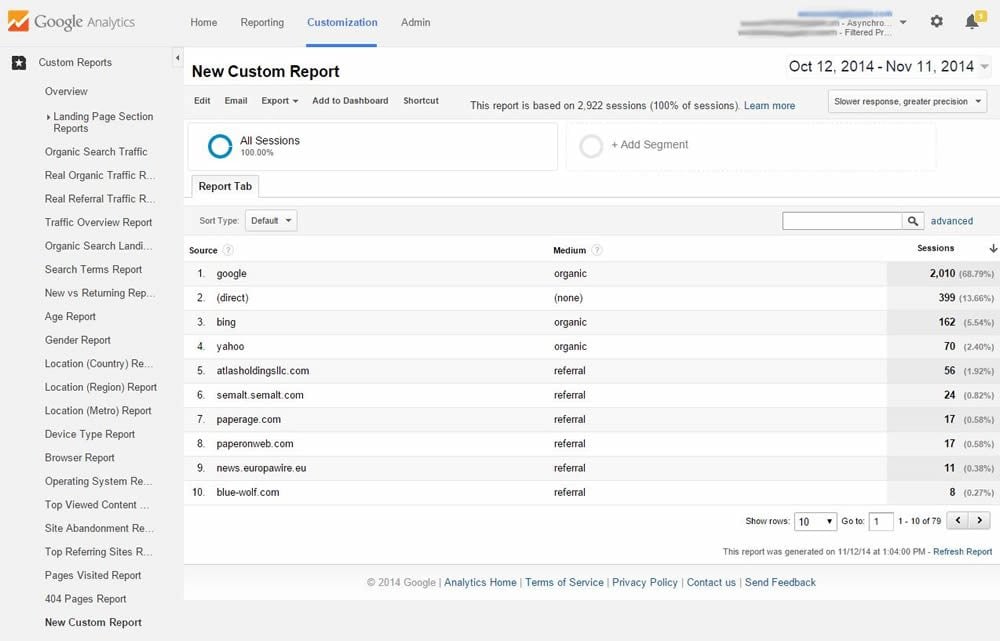Comprehensive Insights Making Use Of Secondary Dimension in Google Analytics
Wiki Article
Transform Your Analytics Strategy With Secondary Dimension in Google Analytics
By incorporating additional dimensions into information evaluation, a new layer of understandings arises, dropping light on elaborate customer actions and interactions. The tactical application of additional dimensions holds the crucial to opening a prize chest of invaluable details that can change just how services analyze and act upon their information.Understanding Secondary Dimensions in Google Analytics
Secondary dimensions in Google Analytics supply additional context to key data by permitting customers to examine metrics throughout a second dimension, supplying deeper understandings into user habits and interactions on an internet site. Secondary Dimension in Google Analytics. While primary dimensions provide fundamental data factors such as pageviews, bounce price, and session duration, second dimensions supply a more detailed view by segmenting the main information further. This segmentation enables customers to evaluate metrics in mix with an additional dimension, such as website traffic resources, demographics, or individual habitsAdvantages of Making Use Of Second Measurements
Utilizing secondary measurements in Google Analytics offers a calculated advantage by improving the deepness of evaluation and offering an extra comprehensive understanding of user interactions and actions on a site. By incorporating additional measurements, experts can gain valuable understandings into the efficiency of details sectors or variables within their information. This allows a more in-depth evaluation of individual behavior beyond surface-level metrics, enabling for a deeper expedition of the factors influencing user interaction and conversions.
How to Apply Secondary Dimensions
When integrating secondary dimensions in Google Analytics, one crucial step is to pick the relevant metrics and measurements to improve the evaluation process. To implement secondary dimensions successfully, start by accessing your Google Analytics account and navigating to the record you desire to enhance with added data. Once in the report, situate the "Additional Measurement" button, usually located over the information table. Clicking on this button will open up a drop-down food selection listing numerous measurements that can be contributed to your main measurement for deeper insights.After picking the proper secondary measurement, such as 'Source/Medium' or 'Device Classification,' Google Analytics will present the data in a more in-depth format, permitting you to cross-analyze various facets of customer actions. Remember to try out various combinations of click here to find out more secondary and main dimensions to reveal important patterns and trends that can inform your marketing methods. By carrying out additional measurements thoughtfully, you can obtain a much more detailed understanding of your web site or app efficiency and make data-driven decisions to optimize your digital presence.
Studying Data With Second Dimensions
Boost your information evaluation in Google Analytics by incorporating additional measurements to delve much deeper into user actions patterns and maximize your digital advertising techniques properly - Secondary Dimension in Google Analytics. By adding secondary dimensions to your main information, you can acquire important insights that can aid you make informed choices regarding your site or application performance
Evaluating data with second dimensions permits you to sector your main information further, supplying a more comprehensive sight of individual communications. For example, incorporating the primary measurement of 'source/medium' with a second measurement like 'landing web page' can expose which specific web pages are driving traffic from various resources. This info can be crucial in fine-tuning your web content approach or enhancing your marketing campaign to enhance conversions.
In addition, making use of additional measurements enables you to recognize connections between different metrics, aiding you comprehend the effect of numerous variables on individual actions. Whether it's assessing demographics alongside customer involvement metrics or device groups with conversion visit our website prices, secondary measurements encourage you to reveal concealed patterns and patterns that can direct your marketing efforts.
Maximizing Efficiency With Second Dimensions
To enhance the efficiency of information evaluation and decision-making in Google Analytics, integrating second measurements is key to maximizing performance metrics and obtaining deeper insights into individual actions patterns. By making use of second dimensions, analysts can dig beyond surface-level data and discover beneficial relationships that may or else go undetected. This optimization strategy makes it possible for businesses to tailor their advertising and marketing efforts much more successfully, determine locations for enhancement in web site functionality, and improve overall user experience.Second measurements provide a more comprehensive sight of customer interactions by providing added context to key data metrics. As an example, pairing the key dimension of 'landing web page' with an additional dimension like 'tool group' can expose whether certain tools are more likely to drive interaction on specific touchdown web pages. This insight can educate responsive layout enhancements or targeted advertising methods to increase efficiency.
a fantastic read

Conclusion
To conclude, the assimilation of second dimensions in Google Analytics provides businesses with an effective device to enhance their analytics approach. Secondary Dimension in Google Analytics. By diving deeper into customer habits and interactions, marketers can reveal important understandings that can drive performance optimization and improve the overall user experience. Leveraging second dimensions enables for a more thorough evaluation of data, leading to more educated decision-making and customized advertising and marketing effortsSecondary measurements in Google Analytics provide added context to main information by allowing customers to evaluate metrics throughout a second dimension, supplying deeper understandings right into individual actions and interactions on an internet site. While primary measurements provide essential information points such as pageviews, bounce price, and session duration, second dimensions use an even more in-depth sight by segmenting the primary information further.One of the essential advantages of using additional measurements is the ability to uncover correlations and patterns that may not be promptly evident when analyzing data with key measurements alone.When incorporating secondary dimensions in Google Analytics, one essential action is to choose the pertinent metrics and measurements to enrich the analysis process. Matching the main measurement of 'touchdown web page' with a second dimension like 'device category' can disclose whether particular devices are more likely to drive engagement on particular touchdown web pages.
Report this wiki page